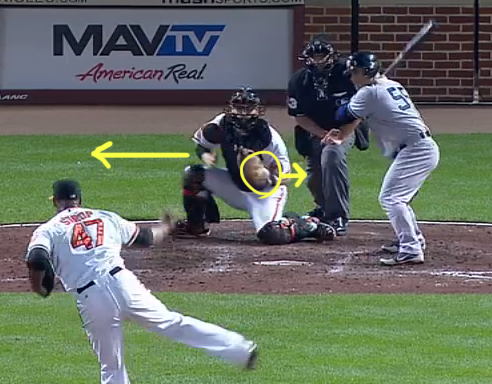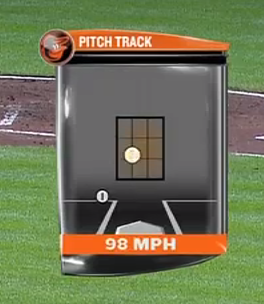How Catcher Framing Can Make or Break a Game
I wrote this post while watching the Yankees play the Orioles on September 6th. With two outs in the top of the 8th inning and Russel Martin batting, the Orioles had a 6-3 lead. Orioles relief pitcher Pedro Strop got two swinging strikes out of Martin in the at bat, but somewhere in the middle there was a wild pitch (well, sort of).
Orioles catcher Matt Wieters set up low and away, and Strop crossed him up—meaning he threw the wrong pitch, or missed his spot in an unexpected way, to the point where Wieters couldn’t get his glove on it in time:

The ball got by him, and the runners moved up.
Now, I’m not criticizing Wieters or Strop at all. As we all know, occasional physical errors are part of the game, whether you’re playing baseball or softball, whether you’re a pro or a little leaguer. So what’s my point in all this?
The pitch was a strike.
Not only was the pitch a strike, but it was a perfect strike, almost right down the middle:

HOWEVER, since Wieters had been crossed up and let the ball get by him, the umpire ASSUMED it was a ball. And he called it a ball. Martin later walked, continuing a rally that allowed the Yankees to tie the game in that inning, when he rightfully should have struck out.
How a Catcher Can Improve a Pitcher’s Success and Win Games
If a professional MLB umpire can be so badly fooled by Matt Wieters’ cross-up, how many strikes do you think your amateur softball umpires have missed? Or, more importantly, if an umpire’s call can be so easily influenced by the actions of the catcher, how can you use that to your advantage? Good catcher framing can dramatically increase a pitcher’s success, and, as you can see from the example above, that can greatly affect the outcome of an inning, or a whole game.
What is Catcher Framing?
If you’re a new catcher or thinking you’d like to try catching and you’re not sure what I’m talking about, catcher framing refers to what the catcher does with her glove when she catches the pitch. If you tend to allow the ball to move your glove with its momentum, you’re not framing. If the ball is a close strike and you allow it to carry your glove out of the strike zone, you may lose the umpire’s call. On the other hand, if you freeze when the ball hits your glove, making it look like the pitcher threw the ball exactly where you wanted it, the umpire is more likely to call in your favor. There are also little tricks you can do, like moving your glove very slightly toward the strike zone, or turning your glove at a particular angle, that can help frame the ball—that is, make close calls look more like strikes.
My point in all of this is that if you’re a young catcher and you’re not practicing your pitch framing, you should be!Catcher framing can make the majority of normal pitches look quite a bit better. This certainly doesn’t mean a decent pitch won’t occasionally get by you; it happens to everyone, and you definitely shouldn’t let a mistake get you down.
The best way to do this is to practice together with your team pitcher or pitchers. Next week, I’ll share a sample practice model that you can follow.